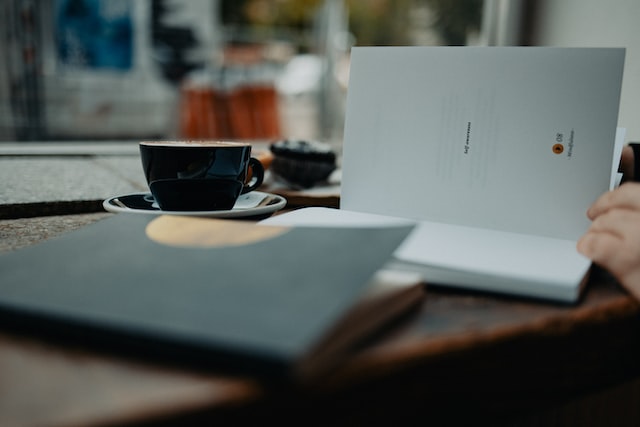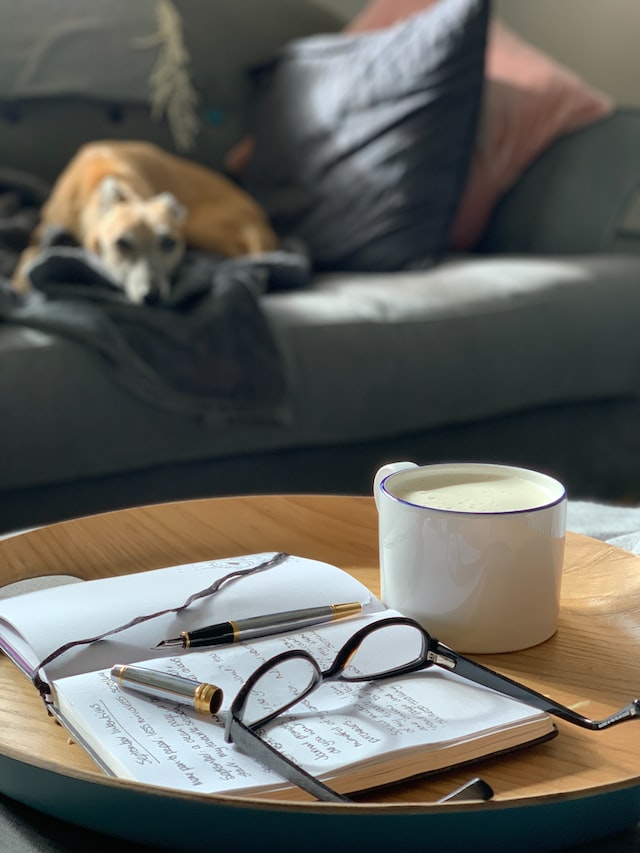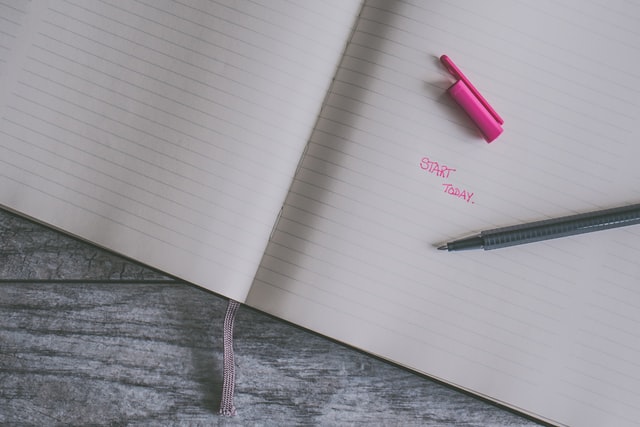I was introduced to the idea of a Commonplace notebook when I read The Country Diary of an Edwardian Lady. I had 2 kids under the age of 4 and I was reviving my learning after being consumed with caring for little ones. I have always been fascinated by journaling and writing out what I am learning. I am a visual learner and so taking notes is part of my learning experience.
What is it? What’s it for?
The word Commonplace has been around since before the Revolutionary War. It has been used as an educational tool for centuries. It is a personalized and effective tool for furthering your own education.
Commonplace books (or commonplaces) are a way to compile knowledge, usually by writing information into books. They have been kept from antiquity, and were kept particularly during the Renaissance and in the nineteenth century. Such books are similar to scrapbooks filled with items of many kinds: sententiae (often with the compiler’s responses), notes, proverbs, adages, aphorisms, maxims, quotes, letters, poems, tables of weights and measures, prayers, legal formulas, and recipes. Entries are most often organized under subject headings[1] and differ functionally from journals or diaries, which are chronological and introspective.”
– Commonplace book. (2022, August 29). In Wikipedia. https://en.wikipedia.org/wiki/Commonplace_book
An earlier definition is the Latin word “Florilegium” or early Greek translation “Anthologion”. These translate literally as a bouquet from the word “gather + flower” and the word “anthology”. Which is a collection of literary extracts and gathered ideas for study from a variety of places for the purpose of learning and growth.
Thomas Jefferson used the phrase “follow truth” a number of times in his writings.
“[T]hey [common-place books] were written at a time of life when I was bold in the pursuit of knolege, never fearing to follow truth and reason to whatever results they led, & bearding every authority which stood in their way.[2]”
– from Thomas Jefferson’s notebook (check out this great resource!)
Ways that I take my commonplace notes:
- While I am reading a book that grabs me with its content, I take notes on phrases that jump out at me.
I read approximately 4-6 books (and audiobooks) a month. I usually only commonplace 1 book at a time. It is typically a non-fiction book that feels unique and extremely helpful for what I am currently learning. I want those notes to come back to and appreciate the quotes that grabbed my attention.
- After I have read a book that really impacted me I sit down and write out a summary.
Occasionally there is a book that has taught me something meaningful that I want to keep preserved to go back to. I am learning in all my reading, but there are a few books that become “an experience”. I want to remember my summary, what I learned, how I applied the information, and what else I was learning at that time. I tend to read books grouped in similar topics and then I distill the information.
- Browsing through a book I have finished and writing out my underlines or notes in the margins.
If there was a book I want to reference and use quotes from I will write down my underlines after I have finished the book. It is a quick re-reading of the material that stuck out to me. This is the equivalent of re-reading the textbook for an exam. It is a visiting the material again to reacquaint myself with what I am learning.
- Somewhere to capture quotes and thought-provoking sayings.
Every now and then I will hear a note-worthy quote on a podcast, in a movie, or see it somewhere in an online article. I keep those in my commonplace notebook. Just one-liners (or maybe a quick paragraph). I always write out the source and I often add why that quote got my attention.
How? Specific details & my routine:
Always write out the reference –
My #1 rule is to always add in where the quote came from. I want to be able to look it up later or share it in my writing and references are a must! Sometimes I even write out other books I am reading at the same time. Any information I can give my future self is helpful.
Chronological order –
I just turn to the next blank page and begin writing notes on the next book or a quote I came across. I have found that chronological order keeps me from overthinking the structure of my commonplace. I also can see themes to my reading and learning over time. It ends up looking a bit like a collected hodge-podge but that’s fine with me!
It doesn’t have to be neat – the goal is done, not perfect
I would rather do something badly than wait for a day when I can write it out perfectly in amazing handwriting with no spelling mistakes. I choose to embrace the current moment in all its flaws. Perfect is the enemy of done. Even if I only get 15 minutes, that is enough.
If I spent 15 minutes every weekday = 75 minutes in a week = 5 1/2 hours per month = about 65 hours per year.
How many books could you read or commonplace notes can you take in that time frame?
I love hearing how other people do things so I can visualize myself doing the task as well. I hope these stories below inspire you to use your Commonplace notebook in a way that fits your life and your day.

scene #1 – kitchen table with coffee and a dessert
My husband just took the kids to Home Depot, my older teen is at work, and I have an hour to myself. Excited, I gather what I need from around the house. I find my book, my commonplace notebook, and my favorite pen. I get a slice of cake (leftovers from the birthday party this weekend) and a hot cup of coffee. I sit at the freshly wiped kitchen table with the window open. I am really enjoying reading Effortless by Greg McKeown. (His first book Essentialism changed my life last year and still holds concepts I am applying.) I am almost half way through and I am finding so many quotes I want to put into my Commonplace. I start at the Table of Contents, write out that page for reference, and then begin writing all the sentenced I underlined. I do my best to have neat handwriting and I use my bullet journal Tombow markers to add headings. This skimming and re-reading process gives me the overview of the chapters I have read and deepens my learning. It is a peaceful, life-giving hour. My brain feels alive and refreshed. When Jim and the kids get home I am ready to move on to sweeping and mopping. I listen to McKeown's podcast while I do my household chores that afternoon.

scene #2 – tucked in a cozy blanket on the couch with my dogs
It has been a long busy day. I am worn out physically and socially but my brain feels parched. I have been meeting the needs of others and investing into an invisible void of homeschooling and homemaking. I want to spend some time with the ideas that I have been reading. The book Growing Slow by Jennifer Dukes Lee has been a kind companion to me and has been a very practical book in my sabbath journey. I finished it last month. I know that tonight what I need is to write the words of others. We are done with kitchen clean up and the kids are done with showers. We all relax on the couches in the living room. The kids play games on their tablets or read books and I gather my commonplace materials. I sit on the couch, in my jammies, with a soft blanket, and my dog snuggled close. On my lap sits my commonplace notebook, my book, sticky notes I made while reading, and my favorite pen. I browse through my underlines and write summaries of each chapter. The author breaks up her book into the 4 seasons of the year and so my notes have the 4 distinct sections of spring, summer, fall and winter. My handwriting is not the best because I am balancing my notebook and book on my lap at the same time. Sometimes my sentences are a bit off. The kids interrupt to share what they are doing or ask me questions, but that's okay. By the time I need to get up to tuck the kids for bedtime, in I am physically rested and mentally satisfied. I will finish my notes another day, but I have made some progress tonight. I feel like I have done something for myself.
Great Resources:
Here are some other resources on Commonplace Notebooks. These inspiring women got me started and encouraged me to take my reading seriously. I am so thankful that I listened and took that step to deepen my learning. Every year I stretch my capacity and continue to grow. I am thankful for those who are walking this same path of learning with me.
- Leah Boden – I love being part of her community called The Collective! You should come join us!
- Her workshop on Commonplace Note-booking was super helpful and practical.
- Susan Wise Bauer – she was my original resource on how to use a commonplace notebook.
- Her book The Well Trained Mind helped me form the foundation for our homeschool and my own renewed learning journey.
- Inspiring short article and the notebook that my kids use and love.
- Schole Sisters – https://scholesisters.com/
- great podcast: Dr. Perrin describes the monastic practice of keeping a commonplace book, called a Florilegium or “Book of Flowers,” and suggests that the benefits of this practice were profound and should be continued today.

Questions for You:
- Do you collect quotes that you enjoy?
- Where do you keep your notes from your reading and online videos?
- What do you enjoy learning about?
- Do you find themes in your notes that go across locations and sources?
- I often find that the topic I am learning about comes up in the sermon on Sunday, in conversations, and in podcasts I listen to regularly. My commonplace notebook helps me make those connections.
- How do you continue your learning journey?
In the process of writing the words of others, we form our own ideas. We are all building on the concepts developed by others. We are standing on the shoulders of those who have come before us.
A quote that I hear often in different ways is something like: “There are no new ideas, only new ways of approaching them.” or “Ideas circle around in our history and society but they have not been written about by you.” I believe that is true. I may not discover something new to humanity or change the world with a new idea, but I can interact with ideas from others that are new to me.
I found such inspiration in the stories of the origins of the word Florilegium.
It is exciting to me to be in vibrant communities that are living out ideas of growth, education, and an abundance of ideas.
📝Happy Notetaking! – April
Photos by Ana Tavares / Becky Fantham / Finde Zukunft on Unsplash
In true Commonplace form, here is my Works Cited. 😁📖
Works Cited:
- Commonplace book. (2022, August 29). In Wikipedia. https://en.wikipedia.org/wiki/Commonplace_book
- The Papers of Thomas Jefferson. (2022, August 31). In Wikipedia. https://en.wikipedia.org/wiki/The_Papers_of_Thomas_Jefferson
- Thomas Jefferson Encyclopedia of his Commonplace Notes – https://www.monticello.org/research-education/thomas-jefferson-encyclopedia/tjpapers/
- Florilegium. (2022, September 11). In Wikipedia. https://en.wikipedia.org/wiki/Florilegium
- Leah Boden – The Collective
- Susan Wise Bauer – The Well Trained Mind
- https://www.jeanniefulbright.com/common-place/
- Schole Sisters – https://scholesisters.com/
- Dr. Perrin – https://open.spotify.com/episode/2G3jcIxn4tg7kyTcZu2azb?si=DJSjmXHpR3KUdeUHnOTCAA&utm_source=copy-link & other resources: https://classicalacademicpress.com/pages/dr-christopher-perrin
